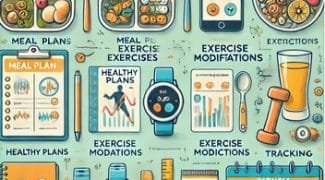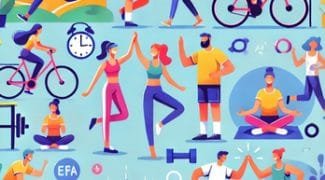

This shows how the Table of Contents Module formats long posts / markdown text.
It is for long posts or pages with markdown text content and it can improve SEO by analyzing the H Ref headings in order and bullet points on the post.
Book Title: Better Health and Fitness is Possible at Any Age
Introduction
- Importance of regular exercise
- Benefits of being active regardless of age or fitness level
- Overcoming the barriers of a sedentary lifestyle
Articles:
- Harvard Health Publishing. "Benefits of Exercise." Accessed January 10, 2024. www.health.harvard.edu.
- American Heart Association. "Why is Physical Activity So Important for Health and Wellbeing?" Accessed January 10, 2024. www.heart.org.
Research Papers:
- Warburton, Darren E.R., Crystal Whitney Nicol, and Shannon S.D. Bredin. "Health benefits of physical activity: the evidence." CMAJ 174, no. 6 (2006): 801-809.
- Pedersen, Bente K., and Mark A. Febbraio. "Muscle as an endocrine organ: focus on muscle-derived interleukin-6." Physiological reviews 88, no. 4 (2008): 1379-1406.
Chapter 1: Understanding the Basics of Fitness
- Page 1: The definition of physical fitness and its components
- Page 2: The impact of a sedentary lifestyle on health
- Page 3: Common misconceptions about fitness and aging
- Page 4: Setting realistic fitness goals
- Page 5: Assessing your current fitness level
- Page 6: Key fitness terminologies and their meanings
- Page 7: The importance of consistency in fitness
- Page 8: Tools and gadgets for tracking fitness
- Page 9: The role of sleep in fitness
- Page 10: Summary and key takeaways from Chapter 1
Chapter 2: Getting Started With Exercise
- Page 1: Choosing the right type of exercise for beginners
- Page 2: Creating a balanced workout routine
- Page 3: Importance of warm-up and cool-down exercises
- Page 4: How to start slow and gradually increase intensity
- Page 5: Staying motivated and consistent
- Page 6: Finding the right time to exercise
- Page 7: Setting up a home workout space
- Page 8: Overcoming initial discomfort
- Page 9: Tracking progress and celebrating small wins
- Page 10: Summary and key takeaways from Chapter 2
Chapter 3: Cardiovascular Exercises
- Page 1: Benefits of cardiovascular exercises
- Page 2: Simple cardio exercises for all ages
- Page 3: Building endurance through regular cardio routines
- Page 4: Monitoring your heart rate
- Page 5: Fun and engaging cardio activities
- Page 6: Cardio exercises you can do at home
- Page 7: Importance of variety in cardio workouts
- Page 8: Using music and apps to enhance cardio sessions
- Page 9: Cardio exercises for different fitness levels
- Page 10: Summary and key takeaways from Chapter 3
Chapter 4: Strength Training
- Page 1: Importance of muscle strength and endurance
- Page 2: Beginner-friendly strength training exercises
- Page 3: Proper techniques and avoiding injuries
- Page 4: Creating a home workout space
- Page 5: Progressing with strength training
- Page 6: Strength training with bodyweight exercises
- Page 7: Using resistance bands and free weights
- Page 8: Strength training for different age groups
- Page 9: Recovery and rest days in strength training
- Page 10: Summary and key takeaways from Chapter 4
Chapter 5: Flexibility and Balance Exercises
- Page 1: Benefits of flexibility and balance exercises
- Page 2: Simple stretching routines
- Page 3: Yoga and its benefits
- Page 4: Balance exercises for stability and fall prevention
- Page 5: Integrating flexibility and balance exercises into daily life
- Page 6: Flexibility exercises you can do anywhere
- Page 7: Using props for flexibility and balance training
- Page 8: Developing a daily stretching routine
- Page 9: Tracking progress in flexibility and balance
- Page 10: Summary and key takeaways from Chapter 5


Chapter 6: Nutrition and Hydration
- Page 1: The role of nutrition in fitness
- Page 2: Creating a balanced diet
- Page 3: Importance of hydration
- Page 4: Healthy eating habits for active lifestyles
- Page 5: Supplements and their role in fitness
- Page 6: Meal planning and preparation tips
- Page 7: Understanding macronutrients and micronutrients
- Page 8: Hydration tips for different types of exercise
- Page 9: Avoiding common dietary pitfalls
- Page 10: Summary and key takeaways from Chapter 6
Chapter 7: Mental Health and Wellness
- Page 1: The connection between physical activity and mental health
- Page 2: Managing stress through exercise
- Page 3: Mindfulness and meditation practices
- Page 4: Overcoming mental barriers to exercise
- Page 5: Creating a holistic wellness plan
- Page 6: The role of social support in mental health
- Page 7: Setting realistic expectations for mental wellness
- Page 8: Integrating mental health practices into daily routines
- Page 9: Finding professional help when needed
- Page 10: Summary and key takeaways from Chapter 7
Chapter 8: Overcoming Common Challenges
- Page 1: Dealing with lack of motivation
- Page 2: Time management for busy individuals
- Page 3: Coping with physical limitations and injuries
- Page 4: Finding support and accountability
- Page 5: Celebrating progress and setting new goals
- Page 6: Creating a supportive environment
- Page 7: Adapting workouts to your lifestyle
- Page 8: Handling setbacks and maintaining momentum
- Page 9: Staying committed during busy times
- Page 10: Summary and key takeaways from Chapter 8
Chapter 9: Long-Term Fitness and Lifestyle Changes
- Page 1: Making exercise a lifelong habit
- Page 2: Adapting routines as you age
- Page 3: Encouraging family and friends to join
- Page 4: Maintaining mental health through physical activity
- Page 5: Embracing an active and healthy lifestyle
- Page 6: Setting long-term fitness goals
- Page 7: Keeping fitness fun and enjoyable
- Page 8: Continuously challenging yourself
- Page 9: Celebrating long-term achievements
- Page 10: Summary and key takeaways from Chapter 9
Chapter 10: Success Stories and Inspiration
- Page 1: Real-life transformations
- Page 2: Interviews with fitness experts
- Page 3: Community success stories
- Page 4: Inspirational quotes and tips
- Page 5: Final encouragement and call to action
- Page 6: Building a personal success story
- Page 7: Lessons learned from fitness journeys
- Page 8: How to stay inspired and motivated
- Page 9: Sharing your fitness story
- Page 10: Summary and key takeaways from Chapter 10
Conclusion
- Recap of the importance of staying active
- Encouragement and final tips
- Inspirational stories of transformation
Appendix
- Sample workout plans
- Nutrition guides
- Resource list for further reading


Chapter 1: Understanding the Basics of Fitness
Page 1
The Definition of Physical Fitness and Its Components
Physical fitness is a state of health and well-being that allows an individual to perform daily activities with vigor, without undue fatigue, and with ample energy to enjoy leisure-time pursuits and to meet unforeseen emergencies. It encompasses several components that work together to ensure the body functions optimally.
1. Cardiovascular Endurance: This is the ability of the heart and lungs to work together to provide the body with oxygen during sustained physical activity. Activities such as walking, running, swimming, and cycling help improve cardiovascular endurance.
2. Muscular Strength: This refers to the amount of force a muscle or group of muscles can exert against resistance. Strength training exercises, like lifting weights or using resistance bands, enhance muscular strength, which is essential for daily activities and overall physical health.
3. Muscular Endurance: This is the ability of a muscle or group of muscles to perform repeated actions without becoming fatigued. Exercises such as planking, squats, and push-ups build muscular endurance, enabling better performance in sports and everyday tasks.
4. Flexibility: Flexibility is the range of motion available at a joint. It’s crucial for preventing injuries and maintaining a good posture. Stretching exercises, yoga, and Pilates improve flexibility, allowing for greater ease of movement and reducing the risk of injuries.
5. Body Composition: This refers to the proportion of fat and non-fat mass in the body. A healthy body composition is often indicated by a lower percentage of body fat and a higher percentage of lean muscle mass. Regular exercise and a balanced diet are key to maintaining a healthy body composition.
6. Balance and Coordination: Balance is the ability to maintain the body's position, whether moving or stationary, while coordination is the ability to use different parts of the body together smoothly and efficiently. Activities like tai chi, balance exercises, and agility drills enhance these components, which are vital for overall functional fitness and injury prevention.
7. Speed: Speed is the ability to move quickly across the ground or move limbs rapidly to grab or throw. This component is often emphasized in athletic training but is also important for daily activities, especially in scenarios that require quick responses.
Understanding these components of physical fitness is the first step towards creating a well-rounded fitness routine. Each component plays a unique role in overall health, and neglecting any one of them can lead to imbalances and potential health issues.
Chapter 1: Understanding the Basics of Fitness
Page 2
The Impact of a Sedentary Lifestyle on Health
A sedentary lifestyle is characterized by a significant amount of sitting or lying down, with very little to no exercise. This type of lifestyle can have numerous adverse effects on overall health and well-being. Understanding these impacts is crucial to motivating individuals to incorporate more physical activity into their daily routines.
1. Increased Risk of Chronic Diseases: One of the most significant risks associated with a sedentary lifestyle is the increased likelihood of developing chronic diseases. These include heart disease, diabetes, and certain types of cancer. Regular physical activity helps regulate blood sugar levels, improves heart health, and boosts the immune system, reducing the risk of these conditions.
2. Weight Gain and Obesity: Lack of physical activity is a major contributor to weight gain and obesity. When the body is inactive, it burns fewer calories, leading to an energy imbalance. Over time, this can result in excessive weight gain. Exercise helps to maintain a healthy weight by increasing the number of calories burned and promoting muscle growth.
3. Musculoskeletal Problems: A sedentary lifestyle can lead to various musculoskeletal issues, including back pain, poor posture, and weakened muscles. Prolonged sitting puts stress on the spine and can cause or exacerbate back problems. Regular exercise, particularly strength training and flexibility exercises, helps to strengthen muscles and improve posture.
4. Mental Health Issues: Physical inactivity is also linked to mental health problems such as depression and anxiety. Exercise has been shown to improve mood, reduce symptoms of depression, and enhance overall mental well-being. Engaging in regular physical activity releases endorphins, which are natural mood lifters.
5. Decreased Metabolic Function: A sedentary lifestyle can lead to a slower metabolism, which affects the body’s ability to break down fats and sugars efficiently. This can contribute to metabolic syndrome, a cluster of conditions that increase the risk of heart disease, stroke, and diabetes. Exercise helps to boost metabolism and improve metabolic health.
6. Poor Cardiovascular Health: Lack of physical activity negatively impacts cardiovascular health. It can lead to higher blood pressure, elevated cholesterol levels, and increased risk of heart disease. Regular cardiovascular exercise strengthens the heart, improves circulation, and helps maintain healthy blood pressure and cholesterol levels.
7. Reduced Mobility and Flexibility: Inactivity can result in decreased mobility and flexibility, making daily activities more challenging and increasing the risk of falls and injuries. Engaging in flexibility and balance exercises helps to maintain and improve mobility, reducing the risk of these issues.
8. Lower Bone Density: A sedentary lifestyle can lead to lower bone density, increasing the risk of osteoporosis and fractures. Weight-bearing exercises, such as walking and resistance training, are essential for maintaining bone health and density.
Understanding the negative impacts of a sedentary lifestyle underscores the importance of incorporating regular physical activity into daily routines. Making small changes, such as standing more, taking regular breaks from sitting, and gradually increasing activity levels, can significantly improve overall health and well-being.